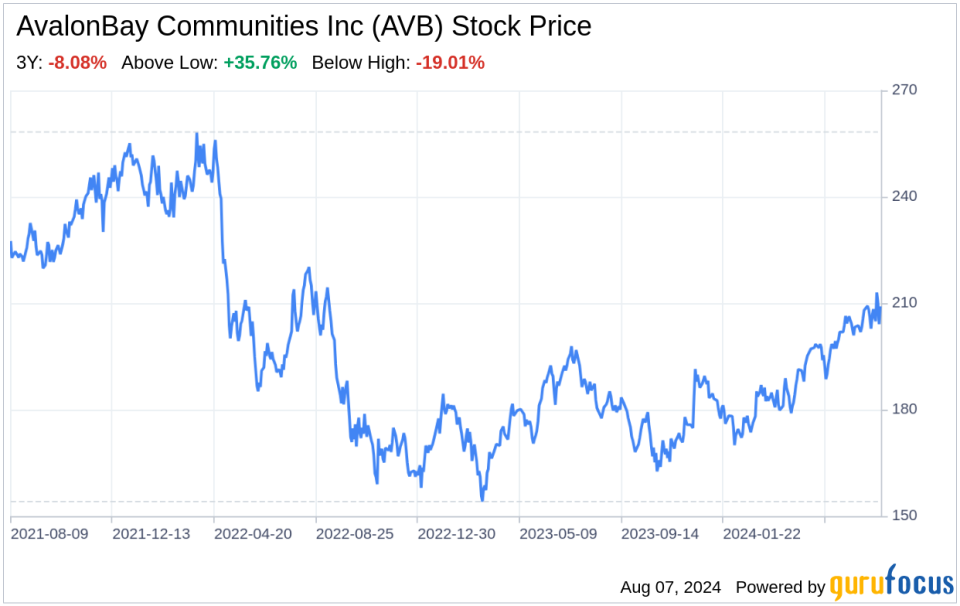Decoding AvalonBay Communities Inc (AVB): A Strategic SWOT Insight
Strengths: Robust Portfolio and Strategic Market Presence
Weaknesses: Market Concentration Risks and Rising Operating Expenses
Opportunities: Expansion in High-Growth Markets and Development Pipeline
Threats: Economic Volatility and Competitive Market Dynamics
On August 6, 2024, AvalonBay Communities Inc (NYSE:AVB) filed its 10-Q report, revealing a comprehensive view of its financial performance and strategic positioning. As a premier owner and operator of apartment communities, AVB reported a revenue increase from $690.86 million in the second quarter of 2023 to $726.04 million in the same period of 2024. Net income attributable to common stockholders showed a decline from $367.92 million in Q2 2023 to $253.93 million in Q2 2024, largely due to a decrease in gains from real estate sales. The company's financial health is further underscored by its earnings per share, which decreased from $2.59 in Q2 2023 to $1.78 in Q2 2024. These figures set the stage for a detailed SWOT analysis, providing investors with a nuanced understanding of AVB's competitive landscape and future prospects.

Strengths
Market Leadership and Quality Portfolio: AvalonBay Communities Inc (NYSE:AVB) boasts a significant presence in some of the most desirable metropolitan areas, including New England, New York/New Jersey, and California. The company's portfolio consists of 281 apartment communities with over 87,000 units, and an additional 18 properties under development. This expansive and high-quality portfolio positions AVB as a leader in the multifamily housing sector, offering a diverse range of living options to meet the demands of urban and suburban dwellers.
Financial Performance and Capital Allocation: AVB's financial performance reflects its operational efficiency and strategic capital allocation. The company's revenue growth, despite a decrease in net income due to lower gains on property sales, demonstrates its ability to generate steady rental income. Furthermore, AVB's disciplined investment in development and redevelopment projects, as evidenced by its projected total capitalized cost of $2,537.00 million for communities under construction, indicates a forward-looking approach to growth and value creation.
Weaknesses
Geographic Concentration: While AVB's focus on major metropolitan areas has its advantages, it also exposes the company to geographic concentration risks. Economic downturns, regulatory changes, or natural disasters in these regions could disproportionately affect AVB's operations and financial results. The company's significant presence in high-cost living areas may also limit its appeal to a broader market during economic contractions.
Rising Operating Expenses: AVB's operating expenses, excluding property taxes, have increased from $169.85 million in Q2 2023 to $179.59 million in Q2 2024. This uptick in expenses could squeeze margins if not managed effectively. As the company expands and upgrades its property portfolio, maintaining cost efficiency will be crucial to sustaining profitability.
Opportunities
Expansion into High-Growth Markets: AVB has the opportunity to expand its footprint into high-growth markets beyond its current geographic focus. The company's expansion into regions such as Raleigh-Durham, Southeast Florida, and Denver presents the potential to tap into new demographics, diversify its income streams, and mitigate risks associated with market concentration.
Robust Development Pipeline: With 17 communities under construction and plans for an additional 30, AVB's robust development pipeline is a significant opportunity for growth. These projects, expected to add nearly 16,000 units, represent a strategic investment in the future of the company, catering to the evolving needs of modern renters and positioning AVB to capitalize on market demand.
Threats
Economic Volatility: The multifamily housing market is sensitive to economic cycles. Factors such as interest rate fluctuations, employment levels, and housing affordability can impact rental demand and revenue. AVB's performance is susceptible to these macroeconomic conditions, which could lead to variability in occupancy rates and rental income.
Competitive Market Dynamics: The apartment rental market is highly competitive, with numerous players vying for market share. AVB faces competition from other REITs, private developers, and property management companies. To maintain its competitive edge, AVB must continuously innovate, offer superior amenities, and ensure customer satisfaction to attract and retain residents.
In conclusion, AvalonBay Communities Inc (NYSE:AVB) exhibits a strong market presence and financial foundation, with a quality portfolio and strategic geographic focus. However, the company must navigate the challenges of market concentration and rising operating expenses. Opportunities for expansion and a robust development pipeline position AVB for future growth, while economic volatility and competitive pressures remain significant threats. Investors should weigh these factors carefully when considering AVB's long-term prospects.
This article, generated by GuruFocus, is designed to provide general insights and is not tailored financial advice. Our commentary is rooted in historical data and analyst projections, utilizing an impartial methodology, and is not intended to serve as specific investment guidance. It does not formulate a recommendation to purchase or divest any stock and does not consider individual investment objectives or financial circumstances. Our objective is to deliver long-term, fundamental data-driven analysis. Be aware that our analysis might not incorporate the most recent, price-sensitive company announcements or qualitative information. GuruFocus holds no position in the stocks mentioned herein.
This article first appeared on GuruFocus.